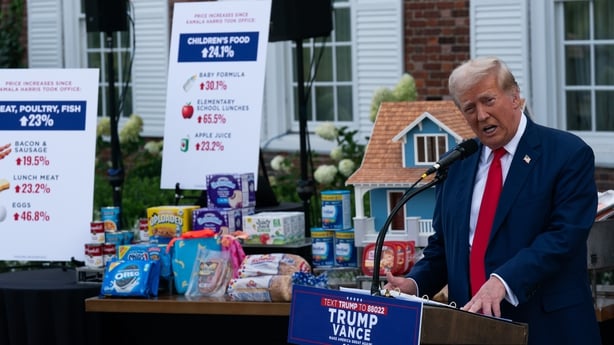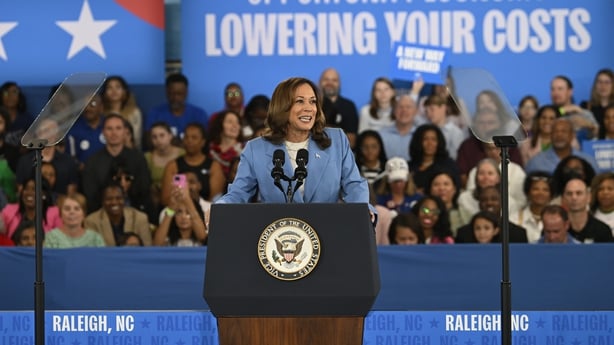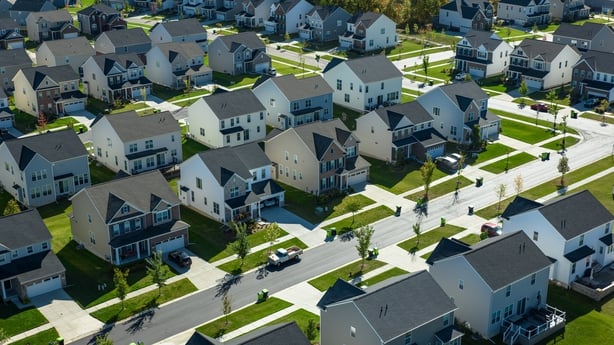Kamala Harris is vulnerable on the cost of living. As an incumbent politician, she owns the nasty price rises that have racked the US over the past three and a bit years. That's the way it goes in politics.
So Donald Trump has a more or less free shot on goal: all he has to do is keep sticking the ball in the back of the net to keep persuading that part of the electorate that is still in play that he is a better bet than her when it comes to bringing down the high cost of living in the US.
It's the one advantage that all politicians who are not in government have - they can monster the ruling party on cost-of-living issues - usually with dollops of emotion instead of bothersome facts. Trump's killer line: "Do you feel better off now than you did four years ago, when I was President?"
He used the line in his press conference on Thursday evening. It was supposed to be all about combating the cost of living for ordinary Americans.
Rather incongruously, he emerged from his Bedminster Golf Resort and residence to talk about the price of groceries, flanked by two tables full of typical consumer products - breakfast cereal, fresh fruit, instant coffee and the like.
But instead of a short, sharp message on what he would do, and a sharp attack on Kamala Harris for being in government when the prices went up, Trump rambled all over the place for two hours, reprising his usual lines on everything from Afghanistan to Xi Jinping. The anti-inflation stuff got buried under an avalanche of verbiage.

By contrast Kamala Harris was short, sharp and focused when she addressed the cost-of-living issue in Raleigh, North Carolina, on Friday. NC has drifted in and out of being a battleground state - mostly it's been out, with the Republicans having a solid lock on the state since Obama won it in 2008 by a tiny margin.
Trump won it by 1.4% in 2020, and various pollsters and Democratic party strategists think it might just be worth Harris spending a little time and money there because of the surge in support she has enjoyed since joining the race. It's certainly worth a punt at this early enough stage of the campaign.
And it ought to be fertile ground for a message aimed at the broad American middle class - an ill-defined lump of demography that makes up a shade over half the US electorate by the usual definition of those earning between two thirds and double the median income. It is roughly those on $50,000 to $155,000 (about €45,000-€140,460).
It also includes those on lower incomes who aspire to be part of the US middle class - the group for whom a comfortable life and the basics of the American dream are supposed to be a given.
But not these days - mostly thanks to inflation in the immediate term, but also due to longer term stagnation and decline in earning power and the near doubling of the size of the high income part of society over the last 50 years (and a small rise in the low income segment too), the middle class has been feeling the strain on many fronts: housing, employment, cars, education, medical bills - and most acutely right now, grocery bills.
Read More:
Kamala Harris pledges to tackle costs and taxes in US
Trump campaigns in North Carolina as allies push for messaging shift
So, a good time and place for Harris to unveil a populist list of giveaways for the great American middle class. Starting with housing. Just like in Ireland, there is a serious shortage of housing in the US, which has driven up prices and pushed affordability to record high levels for owners and renters.
First-time buyers, just like their Celtic cousins, are trapped in a spiral of fewer homes, rising prices, bigger deposit requirements and ultimately bigger debt levels. If they can get a mortgage. The Federal Reserve (the US Central Bank) has pushed interest rates above 5%, with a knock-on effect on mortgage rates, making borrowing more expensive.
Harris has gone straight at this sector with an aggressive intervention, promising to build three million housing units in a four-year term, and ensuring they are available only to middle- and low-income individuals to rent or buy.

She plans unspecified measures to clamp down on corporate landlords buying up entire developments and colluding or using software to set ever higher rental prices. She is calling on Congress to enact something called the "Preventing the Algorithmic Facilitation of Rental Housing Cartels Act".
At the same time, she is proposing an expansion of existing tax incentives for developers to encourage them to build rental housing that is affordable.
In particular she is proposing a first-ever US tax incentive to housebuilders to produce more starter homes (running alongside an existing tax credit to encourage investment in homes that would otherwise be too difficult or costly to build or renovate).
This is in keeping with the Harris campaign’s overall effort to win over the youth vote, a key part of the electoral coalition that put Joe Biden in the White House, but which has drifted away, disillusioned over Gaza, housing and gloom over their economic prospects.
What then could be more eye catching to this demographic than the big number headliner in Friday’s speech - a $25,000 down-payment (ie deposit) grant for first-time buyers. She thinks the scheme could help over four million first-time buyers over a four-year presidential term.
There is a promise to cut red tape and regulation to speed up housebuilding - including at state and local level, where most of the problems seem to lie, and a 40-billion-dollar federal fund that is supposed to spur innovative housing construction.
This latter is a doubling of an existing Biden administration scheme to help local governments fund local solutions to build housing, including the use of "innovative" financing methods. It is particularly aimed at helping developers and housebuilding companies design and build affordable units for rent and for sale. Some Federal land is also to be "repurposed" to allow rapid construction of affordable housing.
It sounds like a plan. Whether or not it actually is, remains to be seen. But at least it's identifiable as something that looks and sounds like a plan to deal with one the most pressing challenges in this country.

I can't say I heard anything that sounded like a housing plan in Trump’s Bedminster press conference on Thursday, or his equally long winded and rambling interview with Elon Musk on Tuesday. Perhaps one will come - Trump after all has the advantage of actually being a property developer and can talk from experience.
In the meantime, Harris was able to pile on the promises with proposed tax cuts aimed at the great American middle - specifically a restoration of a temporary child tax credit of $3,600 per child to make it permanent, and a $6,000 total tax relief for low- and middle-income earners in the first year of their child's life.
And if you don’t have kids but are in a low earning frontline job, she is promising a $1,500 earned income tax credit.
And she is offering to cancel some seven billion dollars' worth of medical debt, affecting around three million Americans. Again, the high cost of healthcare in America can leave some people with debts they can't manage, and which hold them back from participating in the middle-class American dream.
It's a populist recipe that is deliberately drawn to contrast with Trump's populism. And it doesn’t come with a nice, clear guide to how it's all going to be paid for, Harris says it's deliverable whilst reducing government borrowing. Which sounds like a tax rise is coming for someone. If you are after the 51% in the middle class, and can’t get anything out of the 30% on low incomes, that pretty much leaves the 19% in the high-income bracket and corporations as your only marks.
Trump's 2017 package of tax cuts - which saw big cuts for high income individuals and corporations - are due to expire at the end of next year, unless congress renews them. Thus, the control of congress and White House will be critical in shaping or reshaping the future of these cuts, and the flow of money that results from them. And that means winning in November’s elections. Which is why populist policies are being unleashed from the left and the right.
Trump has attacked Harris’ plans as "extreme left socialism" and the medical reforms as "communism". His own formula for reducing prices appears to be a commitment to a vast expansion of oil exploration and extraction, to cut energy prices for consumers, industry and distribution - and in so doing lower the cost of doing business for all.
The cost of petrol is always a hot issue in a country where people drive long distances as a matter of routine. But when it comes to the kind of focused, near surgical targeting of key sections of the electorate, simply talking about the generalised effects of the price of gas and saying "drill baby drill" may not cut it with those who count on 5 November.





